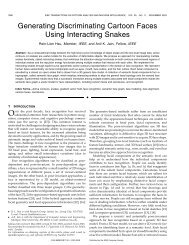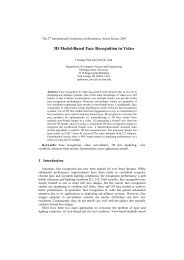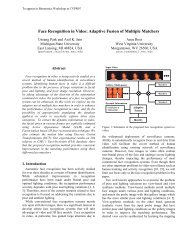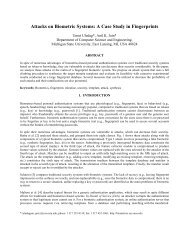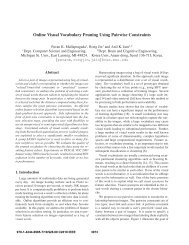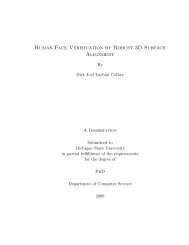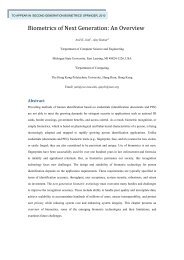Face Detection and Modeling for Recognition - Biometrics Research ...
Face Detection and Modeling for Recognition - Biometrics Research ...
Face Detection and Modeling for Recognition - Biometrics Research ...
You also want an ePaper? Increase the reach of your titles
YUMPU automatically turns print PDFs into web optimized ePapers that Google loves.
(a) (b) (c) (d) (e)<br />
(f) (g) (h) (i) (j)<br />
Figure 3.19. <strong>Face</strong> detection results on half-profile faces. Each example contains an<br />
original image (top) <strong>and</strong> a lighting-compensated image (bottom) overlaid with face<br />
detection results.<br />
90.74% <strong>for</strong> near-frontal faces, <strong>and</strong> to 74.67% <strong>for</strong> half-profile faces. The reason <strong>for</strong> this<br />
decrease in detection rate is the removal of those faces in which the eyes/mouth are<br />
not visible. However, we can see that the number of false positives is dramatically<br />
reduced from 9, 406 after the skin grouping stage to just 27 after the feature detection<br />
stage <strong>for</strong> the whole database containing 206 images.<br />
The Champion database was collected from the Internet, <strong>and</strong> contains 227 compressed<br />
images which are approximately 150 × 220 pixels in size. Because most of the<br />
images in this database are captured in frontal <strong>and</strong> near-frontal views, we present a<br />
single detection rate <strong>for</strong> all poses in Table 3.2. The detection rate <strong>for</strong> the first two<br />
stages is about 99.12%. After the third stage, the detection rate decreases to 91.63%.<br />
86



